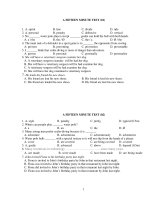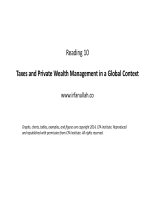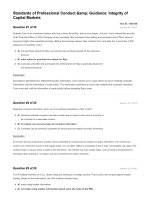Q a schweser self test 03 private wealth management answers
Bạn đang xem bản rút gọn của tài liệu. Xem và tải ngay bản đầy đủ của tài liệu tại đây (248.51 KB, 2 trang )
Question #1 of 6
B) Property risk.
Explanation
With extensive property and complex global business interests they are likely to have substantial
property and potential legal/liability risk that warrant insurance. Given their apparent wealth and
bequest plans the risk that they will have insufficient funds for living expenses is most likely low.
Question #2 of 6
B) Risk tolerance.
Explanation
Although risk tolerance is a critical aspect of an IPS, it is not considered an investment
constraint. The five main categories of investment constraints are liquidity, time horizon, legal
and regulatory concerns, tax considerations, and unique circumstances.
Question #3 of 6
C) 6.5%.
Explanation
Because Chen Wang is currently 61 years old and wants the portfolio to reach 200 million HKD
by the time he is 75, the time horizon for the portfolio is 14 years. The goals are 200 million in
real HKD and annual real distributions of 1 million HKD. The inflation estimate is 1%.Using the
TVM keys: -102 million = PV, 200 million = FV, 1 million = PMT, 14 = N, CPT → I/Y = 5.66% +
1% inflation = 6.66%.
Question #4 of 6
A) regret.
Explanation
The Chens are attempting to avoid the feeling of regret associated with not selling GFTC at its
historical high. This is a stereotypical case of trying to avoid a feeling of if only. If they sold the
stock now, they would say, "If only we had sold GFTC when it was at $X, we would have realized
much more on the investment." In other words, they would have to admit that they were unable
to recognize and take advantage of the historical high. Anchoring refers to locking onto the first
information received and is more common in a forecasting setting. The Chens are showing loss
aversion but myopic loss aversion is something else. It refers to loss aversion that leads to
distortions in the market equity risk premium for equity and is not relevant here.
Question #5 of 6
C) buying an OTM put and sell a further OTM put.
Explanation
Only one choice meets all objectives of reducing the risk, retaining all upside, and reducing initial
cost. Purchase and sale of the puts won't eliminate all risk but it does eliminate risk between the
two strike prices, all upside is retained, and sale of the lower strike price put reduces initial cost.
A collar gives away all upside above the call strike price. The ATM put is the most expensive
strategy and does nothing to reduce initial cost.
Question #6 of 6
C) A discretionary trust with the grandchildren as the beneficiaries.
Explanation
Chen can set the terms of the trust to direct the trustee in what she wants to achieve but then
leave the trustee discretion how best to respond to changing circumstances. Term insurance that
pays when the grandchildren die meets none of the objectives. A deferred start annuity meets
some objectives by making payouts to the grandchildren over time rather than all at once and
could even be set up to start payments coincident with the anticipate date of the estate. But costs
are high for such annuities and given the size of the funds, self-insurance, i.e. put the money in
trust and invest the funds, would be more likely to increase family wealth.









